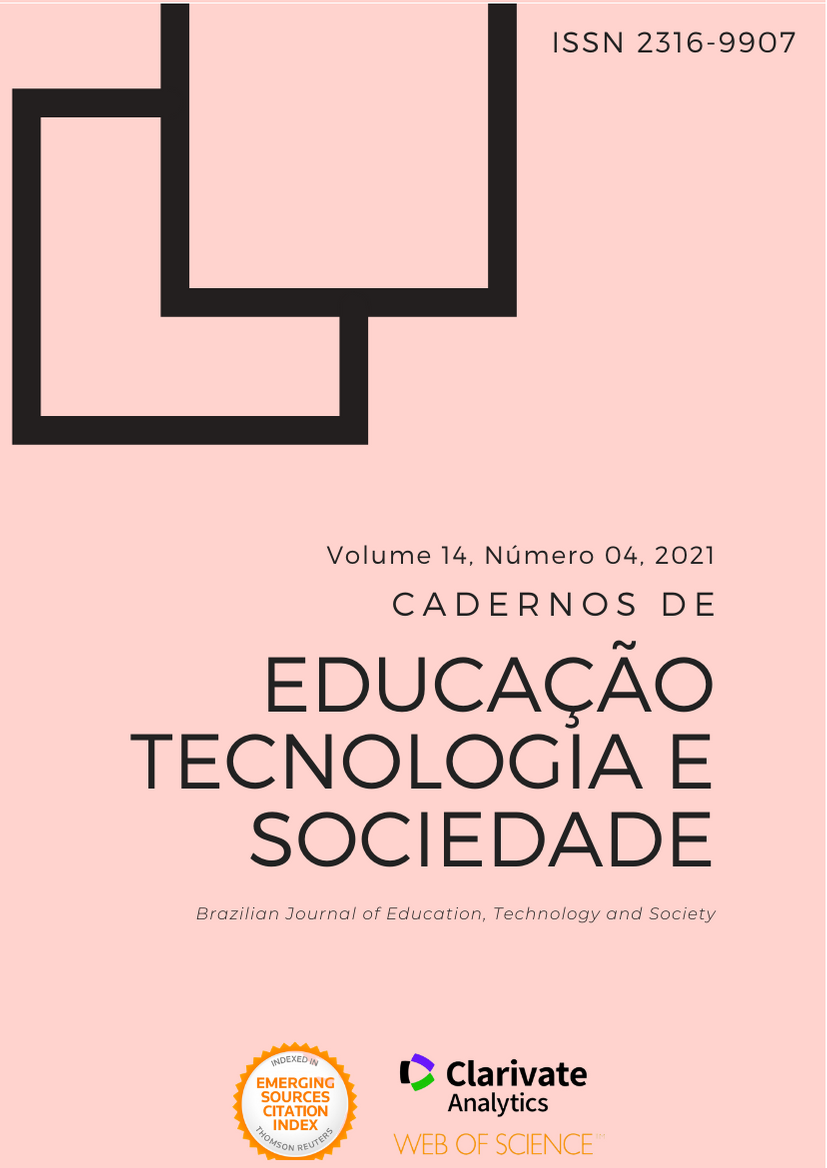Covid-19 e Modelos de Medição e Avaliação à Distância no Ensino Superior
DOI:
https://doi.org/10.14571/brajets.v14.n4.641-646Resumo
A pandemia da COVID-19 tem colocado enormes desafios à sociedade. Várias medidas estão a ser tomadas no ensino superior, uma vez que se pode esperar que as aulas online persistam durante vários meses. Contudo, coloca-se a questão da avaliação, para a qual muitas instituições não estão preparadas. Esta perspetiva visa explorar vários modelos e práticas de avaliação formativa e sumativa que podem ser adotados no contexto do e-learning. Além disso, pretende identificar um conjunto de boas práticas e desafios que podem ser identificados no processo de migração para o modelo de ensino de e-learning. Este estudo é relevante na dimensão prática para as instituições de ensino superior adotarem novas abordagens de monitorização e avaliação das atividades desenvolvidas pelos estudantes no ambiente do e-learning.Referências
Almeida, F., & Buzady, Z. (2019). Assessment of Entrepreneurship Competencies Through the Use of FLIGBY. Digital Education Review, 35, 151-169.
Alonso-Díaz, L., & Yuste-Tosina, R. (2015). Constructing a Grounded Theory of E-Learning Assessment. Journal of Educational Computing Research, 53(3), 315–344.
Borges, J. P., Junior, F. A., Faiad, C., & Rocha, N. F. (2014). Individual competences of distance education tutors. Educação e Pesquisa, 40(4), 935-950.
Cerezo, R., Bogarín, A., Esteban, M., & Romero, C. (2020). Process mining for self-regulated learning assessment in e-learning. Journal of Computing in Higher Education, 32(1), 74–88.
Comerford, L., Mannis, A., DeAngelis, M., Kougioumtzoglou, I. A., & Beer, M. (2018). Utilising Database-Driven Interactive Software to Enhance Independent Home-Study in a Flipped Classroom Setting: Going beyond Visualising Engineering Concepts to Ensuring Formative Assessment. European Journal of Engineering Education, 43(4), 522–537.
Faraniza, Z. (2021). Blended learning best practice to answers 21st century demands. Journal of Physics: Conference Series, 1940, 1-9.
Gikandi, J. W. (2021). Enhancing E-Learning Through Integration of Online Formative Assessment and Teaching Presence. International Journal of Online Pedagogy and Course Design (IJOPCD), 11(2), 48-61.
Groen, M. M., & Eggen, T. J. H. M. (2020). Educational Test Approaches: The Suitability of Computer-Based Test Types for Assessment and Evaluation in Formative and Summative Contexts. Journal of Applied Testing Technology, 21(1), 12–24.
Houston, D., & Thompson, J. N. (2017). Blending Formative and Summative Assessment in a Capstone Subject: «It’s Not Your Tools, It’s How You Use Them». Journal of University Teaching and Learning Practice, 14(3). 1-13.
Kasani, H. A., Mourkani, G. S., Seraji, F., & Abedi, H. (2020). Identifying the Weaknesses of Formative Assessment in the e-Learning Management System. Journal of Medical Education, 19(2), 1-7.
Korpi, S. (2019). Portfolio Project as Summative Language Assessment: Engaging Learners Online. International Journal of E-Learning & Distance Education, 34(2). 1-18.
Lara, J. A., Aljawarneh, S., & Pamplona, S. (2020). Special issue on the current trends in E-learning Assessment. Journal of Computing in Higher Education, 32, 1-8.
Markova, T., Glazkova, I., & Zaborova, E. (2017). Quality Issues of Online Distance Learning. Procedia – Social and Behavioral Sciences, 237, 685-691.
Miranda, R. J., & Hermann, R. S. (2015). Methods & Strategies: Teaching in Real Time. Science and Children, 53(1), 80–85.
Naidu, S. (2017). Openness and flexibility are the norm, but what are the challenges? Distance Education, 38(1), 1-4.
Namyssova, G., Tussupbekova, G., Helmer, J., Malone, K., Afzal, M., & Jonbekova, D. (2019). Challenges and Benefits of Blended Learning in Higher Education. International Journal of Technology in Education, 2(1), 22-31.
Olasina, G. (2018). Factors of Best Practices of E-Learning among Undergraduate Students. Knowledge Management & E-Learning, 10(3), 265–289.
O’Neil, H. F. (2005). What Works in Distance Learning: Guidelines. Charlotte, NC: Information Age Publishing.
Schoepp, K. (2019). The State of Course Learning Outcomes at Leading Universities. Studies in Higher Education, 44(4), 615–627.
Serdyukov, P. (2017). Innovation in education: what works, what doesn’t, and what to do about it? Journal of Research in Innovative Teaching & Learning, 10(1), 4-33.
Souza, A. M., & Polonia, A. C. (2015). Tutoring in Distance Education: New Proposals, Challenges and Reflections. International Journal of Educational Excellence, 1(2), 53-80.
Torres, A. P., Pimenta, L. A., & Kerbauy, M. T. M. (2017). O uso efetivo das tecnologias de informação e comunicação (TIC) no ensino superior. Conhecimento e Diversidade, 9(18), 123–143.
Tucker, R., & Morris, G. (2010). Anytime, anywhere, anyplace: Articulating the meaning of flexible delivery in built environment education. British Journal of Educational Technology, 42(6), 904-915.
Vershitskaya, E. R., Mikhaylova, A. V., Gilmanshina, S. I., Dorozhkin, E. M., & Epaneshnikov, V. V. (2020). Present-Day Management of Universities in Russia: Prospects and Challenges of E-Learning. Education and Information Technologies, 25(1), 611–621.
West, R. E. (2009). Insights from research on distance education learners, learning, and learner support. Distances et Savoirs, 7, 571-584.
Downloads
Publicado
Edição
Seção
Licença
Copyright (c) 2021 Fernando Almeida, Sergio Sargo Lopes

Este trabalho está licenciado sob uma licença Creative Commons Attribution 4.0 International License. A revista segue a política para Periódicos de Acesso Livre, oferecendo acesso livre, imediato e gratuito ao seu conteúdo, seguindo o princípio de que disponibilizar gratuitamente o conhecimento científico ao público proporciona mais democratização internacional do conhecimento. Por isso, não se aplica taxas, sejam elas para submissão, avaliação, publicação, visualização ou downloads dos artigos. Além disso, a revista segue a licença Creative Common (CC BY) permitindo qualquer divulgação do artigo, desde que sejam referenciados o artigo original. Neste sentido, os autores que publicam nesta revista concordam com os seguintes termos: A) Os autores mantém os direitos autorais e concedem à revista o direito de primeira publicação, com o trabalho simultaneamente licenciado sob a Creative Commons Attribution License (CC BY), permitindo o compartilhamento do trabalho com reconhecimento da autoria do trabalho e publicação inicial nesta revista. B) Autores têm autorização para distribuição não-exclusiva da versão do trabalho publicada nesta revista (ex.: publicar em repositório institucional e não institucional, bem como capítulo de livro), com reconhecimento de autoria e publicação inicial nesta revista. C) Autores sãoo estimulados a publicar e distribuir seu trabalho online (ex.: repositórios online ou na sua página pessoal), bem como aumentar o impacto e a citação do trabalho publicado.

